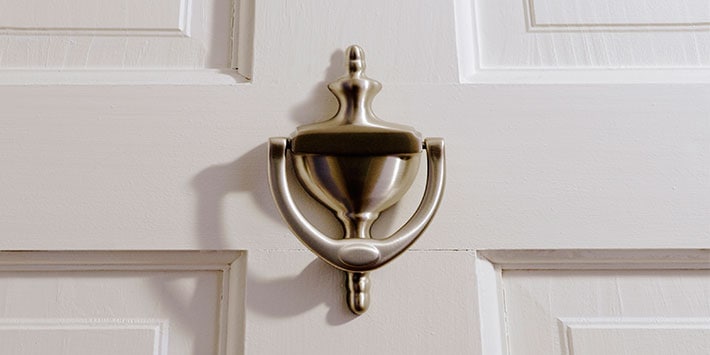

John F. Muffler
U.S. Marshal (Ret.)
Your home is your castle — or so the old saying goes. You want to feel safe and secure and live comfortably without fear of intrusion. You want a layer of security for your loved ones so they will be able to live and sleep peacefully, knowing their surroundings are secure. Good locks, lighting, landscaping and security systems are measures a homeowner can use to help provide effective security for their home. But the security footprint for your home starts beyond the brick and mortar of the home’s exterior. It starts at the street, curb, tree line and — in this internet age — beyond.
There are multiple layers of residential security, and each layer is related. To provide a safe environment, these layers must work cohesively to achieve optimum effectiveness.
Inherent risks are associated with serving as a judge. Decisions can often cause reactions from litigants, family members and the general public. Judges are viewed as the embodiment of the judicial system and are, unfortunately, held responsible for the results, even when decisions are legally based and beyond their personal control. Therefore, disgruntled litigants may not be upset with the judge as an individual, but with the institution they represent. This can often place the judge, as well as his or her family and staff, at risk. Acknowledging this inherent risk is the first step in having the proper mindset. Law enforcement can provide resources, but judges must remember that security starts with them.
For the most part, courthouses are safe and secure. With security officers, magnetometers, x-rays, cameras, duress alarms, ballistic barriers, high grade locks and lighting, they provide an excellent security blanket. However, when you step out of the courthouse, your vulnerability skyrockets. You no longer have the systems and personnel at your disposal. Proper security education and countermeasures will help mitigate the risks to you and your loved ones while away from the court, at home or in transit.
A recent security survey of National Judicial College membership shows significant concerns regarding workplace and personal security measures for judges. It is incumbent on you to be proactive in developing a secure lifestyle. This begins with effective communication with security and law enforcement officials responsible for your security. It is equally important that this line of communication extend to your family and staff. Often, a few simple security measures can mitigate risks to you and your family.
A Brief, Tragic History of Attacks at Home
Attacks on judges and their families are rarely random. Most potential predators conduct preliminary research and surveillance on their intended victim. This is where predators are vulnerable to detection. They look for where to strike, when to strike and how to escape. This is not simply a part of the predator’s strategy, but part of their psychological makeup. The steps of an attacker’s pathway to violence are grievance, ideation, research and planning, preparation, breach and then the attack (Calhoun and Weston, 2003). Your castle is the likely point of attack.
To emphasize the importance of offsite security and the dangers of being away from the protective confines of the court, Susan P. Baker chronicles in her book Murdered Judges of the Twentieth Century, disturbing statistics. From the period 1909–1999, 21 judges, along with four spouses, were killed away from the court. Murdered Justice, a recent study on attacks to justice personnel from 1950-2013, found that 51 percent of the attacks occurred at the residence with a 68 percent kill rate (McGovern, 2013).
The murders of United States District Court Judge Joan Lefkow’s husband and mother, and the murder of Federal Judges Robert Smith Vance, Richard J. Daronco and John A Wood, Jr., all occurred at their residences. In June 2013, an assassin’s bullet narrowly missed the head of United States District Court Judge Timothy J. Corrigan, while he sat in his favorite chair at home.
Concentric Layers
The term “curb appeal” is often associated with real estate to describe how a home is presented to potential buyers perusing the neighborhood. Potential assailants or burglars make a calculated determination of a home’s “curb appeal” or vulnerability and balance the potential risks versus potential rewards.
Burglaries occur every 13 seconds (FBI, 2013) in the United States, mostly during work hours. While burglars usually spend less than 60 seconds trying to break into your home, they spend on average 10 minutes inside. Home intrusion detective systems are excellent deterrents; homes without them are three times more likely to be burglarized (FBI, 2013). The front door and lower level windows are the likely entry points, according to the FBI.
Think of your home and security in terms of concentric circles. The most important part of your home is your family, and it should be the focus of your security plan. From that epicenter to the outer walls are multiple layers of security. These concentric layers of security are analogous to the features of a medieval castle. For instance, the structure may have consisted of a moat, drawbridge, high walls, armed guards, interior walls and additional layers of security extending internally to the center. The concentric layers of your castle’s security, from the outer perimeter to the epicenter, should consist of proper lighting and well-maintained landscaping that allows good lines of sight; quality locks, doors and windows; a home security system; and an identified safe area within the residence. These visual and physical barriers are designed to be impediments that allow you to place time and distance between you and your assailant. Beyond physical barriers, you should also have an emergency action plan, coupled with open, candid communication about crisis situations with your family. This strategic plan should consist of responding to and evacuating from potential emergencies.
Let’s turn now to a step-by-step look at concentric layer countermeasures. The three essential principles of layered security are: deter, detect and delay. When any of these elements are met, they will place time and distance between you and the potential threat. But remember, they will not stop an assailant.
Lighting
A well-lit house is a far more formidable obstacle to a burglar. Statistics confirm that a home with a well-lit exterior is less likely to be burglarized than one that is poorly lit. Several types of lighting systems can significantly reduce the risks of intrusion. Motion lights illuminate when a person or vehicle gets close enough to activate the sensor. Sensing devices should be placed in locations that are out of reach so that they cannot be easily tampered. Dual motion lights illuminate large areas simultaneously, for example, areas around the driveway and walkway of the house. Well-placed, motion- activated lights can act as an alarm when triggered, frightening away potential intruders. Uniformity of lighting will reduce shadows and potential hiding places. If the interior of the home is lit, blinds or shades should be closed, preventing a clear line of sight for the assailant.
Landscaping
Landscaping and exterior lighting comprise the critical first layer of home protection. As previously mentioned, the home’s curb appeal is a significant factor to a possible intruder. You can take simple steps to make the exterior of your home less inviting to intruders. Keep shrubs trimmed to remove hiding places and keep the structure visible from the street. Shrubs near the house should be trimmed at three feet or less to remove hiding places. Trees located near the front of the residence should be maintained at a height of around seven feet. This is called the three-to-seven pruning rule. More importantly, the gap between three and seven feet allows for good lines of sight from inside to outside the house. This may result in some loss of privacy, but it’s a significant gain in security. Illuminate trees and provide landscape lighting to shrubs to increase exterior visibility. Prickly, thorny plants placed under windows or along fence lines can also deter intruders.
Trestles along the side of the home should not be near windows because they can be used as a ladder to gain entry. Outlying sheds or storage areas should be secured to prevent ladders and tools from being used to access upper windows, breach doors or as potential weapons.
Locks and Doors
Good locks and sturdy doors are key elements to home security and the biggest impediments for an intruder. But, they are a delay tactic and alone won’t stop an intruder.
The exterior doors of your home should be solid wood or metal, preferably with minimal to no glass. Deadbolt locks offer tremendous protection. For maximum effectiveness, the door should be flush with the frame and the bolts should enter an inch into a well-constructed frame. Locks that have a thumb turn from the inside of the house are single cylinder and should not be used on doors where a window can be broken and the knob turned to open. Doors with these types of windows should have double cylinder deadbolts, which require a key internally to exit. Obviously, the key should not be left in the knob. While convenient, hiding a key outside is never a good idea.
“Key bumping” is a phenomenon by which most pin tumbler locks are easily picked. This is the standard type of lock on most doors. To counter key bumping, install a high quality lock equipped with lock resistant features. Aftermarket door security bars are an inexpensive but effective secondary devise to further delay entry.
Windows
Because they are easily broken to gain entry, windows are the weakest and most vulnerable part of the house. There are, however, several ways to counter the use of windows as an entry point. Do not leave tools, loose bricks or similar objects lying around the yard. They can easily be used as an instrument for entry. Many windows have a laminate between the two plates of glass that require multiple blows to shatter the window. Most burglars want to avoid noise in gaining entry. If you do not have such windows, consider an aftermarket laminate.
Needless to say, keep your windows locked. Good secondary techniques include window pinning, where a nail or pin can be placed in the frame of the sliding part of the window. This prevents an intruder from being able to lift out the window. For sliding glass or horizontal windows, place an old broom handle at the base and track filler or dowel into the upper part of the glass. This too will prevent the door or window from being lifted out of the panel.
Home Intrusion Detection Systems
A home security system is critical for the safety and security of your family. As stated earlier, homes without them are three times more likely to be burglarized (FBI, 2013).
With today’s technologies, the capability of home security systems is only limited by the amount you want to spend. At a minimum, it should consist of control panels in the primary bedroom and lower level, glass break detectors, door and window contacts, motion detectors and an alarm annunciator. It also is wise to have cell guard in the event the land line phone is lost and/or cut. Additional common features include: carbon dioxide, smoke/heat and fire detectors; panic button key fob; intercom; closed circuit television equipment; and the ability to monitor your system via smartphone, laptop or tablet.
Since 60 percent of burglaries occur while the home is occupied (FBI, 2013) it is critically important that if you have a home intrusion detection system, you should use it constantly. Most home security systems are activated and deactivated using a passcode. Always keep this code closely held.
Safe Room/Safety Plans
Your home emergency strategy should also include the identification of a secure area of the home in the event of an intrusion, particularly if exiting the house is not an option. A safe room need not resemble what you would see in a Hollywood movie. It should have a solid core door with secure locks, a wireless phone (with cell guard security), or a cell phone to call 911. Isolating yourself from the intruder will provide enough time for an emergency response or perhaps dissuade the intruder from progressing further. While in the safe room, stay away from the door and open a window to summons help. Depending on the floor where your safe room is situated, a rope ladder, which secures to the window frame, can assist in evacuating the premises. If it is possible for a person to safely exit the premises, they should proceed directly to a neighbor’s home and/or call 911. Utilizing safe rooms and practicing evacuation techniques are important for every household. Preparing for “what if” scenarios may save the life of you or your family.
Other Security Elements
Firearms and other types of weapons can provide an additional element of security. If you are inclined to own a firearm, be aware of the laws of your state of residence, particularly as it pertains to the use of deadly force. You should train with your firearm and properly store it in a secure but accessible location. Remember that many children are accidently injured or killed by improperly secured firearms in the home. Children should be taught that the area where firearms are stored is off limits. Canines are another great way to help secure your residence. Big or small, it doesn’t matter as long as they can intimidate an intruder or announce a potential threat.
Summary
All of the above described measures, when taken together, will give the homeowner a distinct advantage if they are the target of a potential assailant. These measures are designed to place critical time and distance between the home occupant and an intruder, and may be enough to deter, detect or delay their advancement. When potential assailants are on the pathway to violence they become vulnerable to detection. Your situational awareness is key to that detection. Moreover, the security measures you undertake for your castle can increase the likelihood of mitigating targeted violence. For additional assistance in securing your home, a home inspection by a security professional and/or your local law enforcement agency, is strongly recommended.
Report all suspicious activity to law enforcement.
» Click here to read a note from NJC President Chad Schmucker
Sensible Tips to Keep You and Your Family Secure
- A proper mindset is critical to personal safety.
- Understand the strengths and weaknesses of your home security footprint.
- Keep the exterior illuminated with good lighting.
- Be aware that well-maintained landscaping can enhance home security.
- Good locks will slow down an intruder.
- Exterior and safe room doors should be solidly constructed.
- Windows and sliding glass doors are easily defeated and should be secured to prevent movement.
- Invest in — and use — a home intrusion detection system.
- Periodically practice “what if” scenarios.
- Constantly communicate with family, staff and law enforcement.
A Note from the NJC President

The National Judicial College was deeply saddened by the news that Texas State Judge Julie Kocurek was shot outside in her driveway in Austin earlier this month.
We are thankful that her injuries are not life threatening. Judge Kocurek is an alumnus of the NJC and we wish her a speedy recovery and would like to share our concern and well wishes to her and her family.
We are always saddened by news of violence against judges, but even more at a loss when we hear it’s someone who is part of our NJC family.
It’s an assault on our democracy if judges can’t make decisions and do what they think is right without worrying about their personal security. It creates a very dangerous situation.
We urge you to make a plan for your safety and to reevaluate this plan often.
The above article offers many valuable tips. Many of our courses include a security element within the curriculum and we would be happy to talk with you about finding the right fit for your needs.
Please take responsibility for your safety and look out for the safety of your colleagues and loved ones.
— Hon. Chad Schmucker

This month’s one-question survey* of NJC alumni asked, “How is 2024 shaping up for you and your court?�...

RENO, NV (PNS) – As they eye their inaugural football season this fall, the Gaveliers have question marks...

RENO, Nev. (March 8, 2024) — In what may reflect a devastating blow to the morale of the judiciary, 9 out...

In what may reflect a devastating blow to the morale of the judiciary, 9 out of 10 judges believe the publi...

RENO, Nev. (Jan. 26, 2024) — The nation’s oldest, largest and most widely attended school for judges �...
